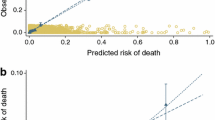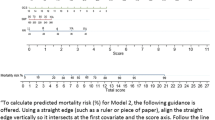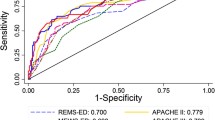Abstract
Objective
To compare patients and their outcomes at ten Brazilian intensive care units (ICUs) with those reported from the United States.
Design
Prospective multicenter inception cohort study.
Setting
Ten Brazilian adult medical-surgical ICUs.
Patients
1734 consecutive adult ICU admissions.
Measurements and results
We used demographic, clinical and physiologic information and the APACHE III prognostic system to predict risk of hospital death for 1734 ICU admissions. We then divided the observed by the predicted hospital death rate to calculate standardized mortality ratios (SMRs) for patient groups and each ICU. Hospital mortality for Brazilian patients (34%) was double that found in the United States (17%,p<0.01). Discrimination of survivors from non-survivors using APACHE III was good (area under a receiver operating characteristic curve=0.82), but the predicted risk of death was significantly (p<0.0001) lower than observed outcome (SMR=1.67). Three of the ten Brazilian ICUs, however, had SMRs of 1.01 to 1.1 and no significant difference between observed and predicted outcomes; the remaining seven ICUs had significatly higher SMRs, ranging from 1.50 to 2.30.
Conclusion
The APACHE III prognostic system was a good discriminator of hospital mortality for ICU admissions at 10 Brazilian ICUs. There was substantial and significant variation, however, in SMRs among the Brazilian ICUs, which suggests that further evaluations of international differences in intensive care using a common risk assessment system should be performed and factors associated with variations in risk-adjusted mortality scrutinized.
Similar content being viewed by others
References
Banta HD (1986) Medical technology and developing countries: the case of Brazil. Int J Health Serv 16: 363–373
Perry S, Marx ES (1992) What technologies for health care in developing countries? World Health Forum 13: 356–361
Jenett B (1984) Inappropriate use of intensive care. BMJ 289: 1709–1711
Chernow B (1993) The practice of critical care-describing who we are, evaluating what we do, and computing the cost. Crit Care Med 21: 1413–1415
Knaus WA, Douglas DP, Draper EA, Zimmerman JE, Bergner M, Bastos PG, Serio CA, Murphy DJ, Lotring T, Damiano A, Harrell FE, (1991) The APACHE III prognostic system: risk prediction of hospital mortality for critically ill hospitalized adults. Chest 100: 1619–1636
Lemeshow S, Teres D, Klar J, Avrunin JS, Gehlbach SH, Rappaport J (1993) Mortality probability models (MPM II) based on an international cohort of intensive care unit patients. JAMA 270: 2478–2486
Gemke RJBJ, Bonsel GJ, van Vught AJ (1994) Effectiveness and efficiency of a Dutch pediatric intensive care unit: validity and application of the pediatric risk of mortality score. Crit Care Med 22: 1477–1484
LeGall JR, Lemeshow S, Saulnier F (1993) A new simplified acute physiology score (SAPS II) based on a European/North American multicenter study. JAMA 270: 2957–2963
Zimmerman JE, Wagner DP, Draper EA, Knaus WA (1994) Improving intensive care unit discharge decisions: supplementing physician judgement with predictions of next day risk for life support. Crit Care Med 22: 1373–1384
Zimmerman JE, Wagner DP, Knaus WA, Willaims JF, Kolakowski D, Draper EA (1995) The use of risk predictions to identify candidates for intermediate care units. Chest 108: 490–499
Knaus WA, Harrell FE, Fisher CJ, Wagner DP, Opal SM, Sadoff JC, Draper EA, Walawander CA, Conboy K, Grasela TH (1993) The clinical evaluation of new drugs for sepsis: a prospective study design based on survival analysis. JAMA 270: 1233–1241
Knaus WA, Draper EA, Wagner DP, Zimmerman JE (1985) APACHE II: a severity of disease classification system. Crit Care Med 13: 818–828
Dragsted L, Jorgensen J, Jensen NH, Bonsing E, Jacobsen E, Knaus WA, Qvist J (1989) Interhospital comparisons of patient outcome from intensive care: importance of lead-time bias. Crit Care Med 17: 418–422
Zimmerman JE, Knaus WA, Judson JA, Havill JH, Trubuhovich RV, Draper EA, Wagner DP (1988) Patient selection for intensive care: a comparison of New Zealand and United States hospitals. Crit Care Med 16: 318–326
Jacobs S, Chang RWS, Lee B, Lee B (1988) Audit of intensive care: a 30 month experience using the APACHE II severity of disease classification system. Intensive Care Med 14: 567–574
Rowan KM, Kerr JH, Major E, McPherson K, Short A, Vessey MP, (1993) Intensive Care Society's APACHE II study in Britain and Ireland-II: outcome comparisons of intensive care units after adjustment for case mix by the American APACHE II method. BMJ 307: 977–981
Rowan KM, Kerr JH, Major E, McPherson, Short A, Vessey MP (1994) Intensive Care Society's acute physiology and chronic health evaluation (APACHE II) study in Britain and Ireland: a prospective, multicenter, cohort study comparing two methods for predicting outcome for adult intensive care patients. Crit Care Med 22: 1392–1401
Milani R, Rocha AS (1989) Prognostic accuracy and efficacy of treatment at intensive care units evaluated by the APACHE II system. Rev Hosp Clin Fac Med Sao Paulo 44: 149–152
Turner JS, Potgieter PD, Linton DM (1989) Systems of scoring severity of illness in intensive care. S Afr Med J 76: 17–20
Joshua N, Jena GP, Mletelwa NV (1989) Multidisciplinary intensive care unit at Cecilia Makiwane Hospital, Mdantsane, Ciskei. S Afr Med J 75: 286–289
Dougnac A (1989) Severity evaluation system: APACHE II, SAPS: national experience in a unit of medical intensive therapy. Rev Med Chil 117: 1357–1362
Hernandez JFR, Brito AE, Galende MLQ, Prendes PN, Pena MS, Correa NP (1990) Dies años de atencion al paciente critico. I. Comparacion de 2 grupos de pacientes ingresados al principio y final de la última década. Rev Bras Terap Intensiva 2: 7–9
Hernandez JFR, Brito AE, Galende MLQ, Prendes PN, Pena MS, Correa NP (1990) Dies años de atencion al paciente critico. II. Comparacion de 2 grupos de pacientes ingresados al principio y final de la última década. Rev Bras Terap Intensiva 2: 10–12
Teoh GS (1991) APACHE II: preliminary report on 100 intensive care unit cases in university hospital, Kuala Lumpur. Med J Malaysia 46: 72–81
Sirio CA, Tajimi K, Tase C, Knaus WA, Wagner DP, Hirasawa H, Sakanishi N, Katsuya H, Taenaka N (1992) An initial comparison of intensive care in Japan and United States. Crit Care Med 20: 1207–1215
Oh TE, Hutchinson R, Short S, Buckley T, Lin E, Leung D (1993) Verification of the acute physiology and chronic health evaluation scoring system in a Hong Kong intensive care unit. Crit Care Med 21: 698–705
Knaus WA, Wagner DP, Zimmerman JE, Draper EA (1993) Variations in mortality and length of stay in intensive care units. Ann Intern Med 118: 753–761
Hanley JA, McNeil BJ (1982) The meaning and use of the area under a receiver operating characteristic (ROC) curve. Radiology 143: 29–36
Schuster DP (1992) Predicting outcome after ICU admission: the art and science of assessing risk. Chest 102: 1861–1870
Hanley JA, McNeil BJ (1983) A method of comparing areas under receiver operator characteristics curves derived from the same cases. Radiology 148: 839–843
Lemeshow S, Hosmer DW (1982) A review of goodness of fit statistics for use in the development of logistic regression models. Am J Epidemiol 115: 92–106
Castella X, Artigas A, Bion J, Kari A, The European/North America Severity Study Group (1995) A comparison of severity of illness scoring systems for intensive care unit patients: results of a multicenter, multinational study. Crit Care Med 23: 1327–1335
Kruse JA, Carlson RW (1993) Severity of illness scoring: east meets west. Crit Care Med 21: 647–649
Haines A (1993) Health care in Brazil. BMJ 306: 503–506
Park RE, Brook RH, Kosecoff J, Keesey J, Rubenstein L, Keeler E (1990) Explaining variations in hospital death rates: randomness, severity of illness, quality of care. JAMA 264: 484–490
Author information
Authors and Affiliations
Additional information
Supported by the Agency for Health Care Policy and Research (HSO7137); The John A. Hartford Foundation (87267); The Department of Anesthesiology, The George Washington University Medical Center, The National Council of Scientific and Technology Development (CNPq), Brazil (No. 202321/98.4); and APACHE Medical Systems Inc
A complete list of study hospitals and participants appears at the end of this article
Rights and permissions
About this article
Cite this article
Bastos, P.G., Sun, X., Wagner, D.P. et al. Application of the APACHE III prognostic system in Brazilian intensive care units: A prospective multicenter study. Intensive Care Med 22, 564–570 (1996). https://doi.org/10.1007/BF01708097
Received:
Accepted:
Issue Date:
DOI: https://doi.org/10.1007/BF01708097




